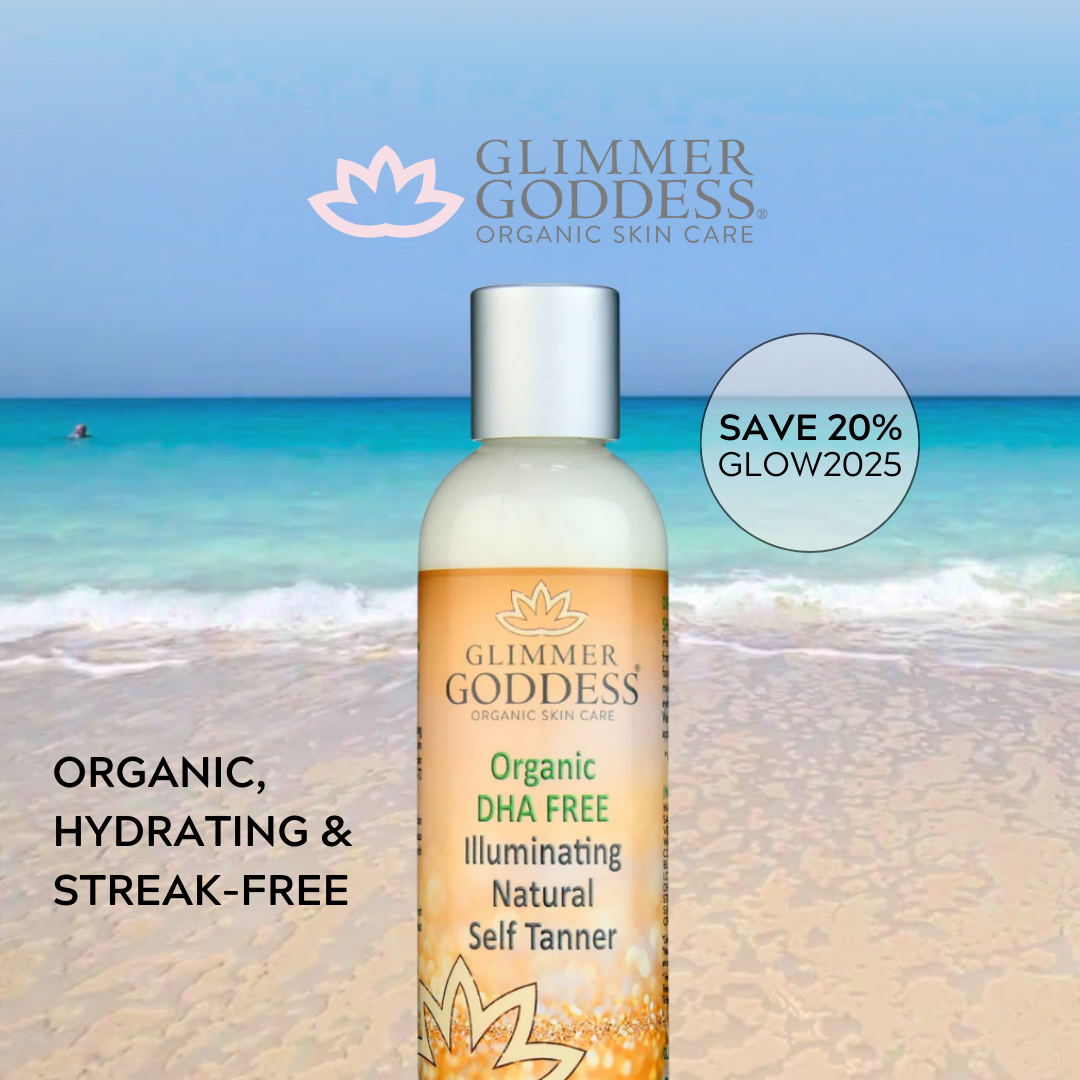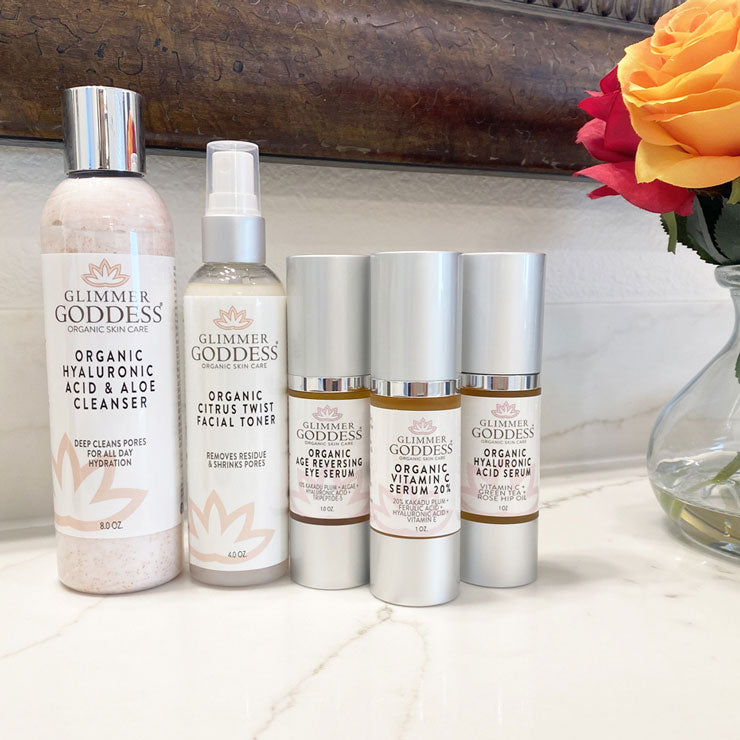Article: DHA-Free Self Tanner Guide | Clean Glow

DHA-Free Self Tanner Guide | Clean Glow
DHA-Free Self Tanner: The Clean Glow Guide from Glimmer Goddess®
For years, traditional self tanners have relied on dihydroxyacetone (DHA) to create color on the skin. But as more people develop sensitivities, read ingredient labels, and lean into clean beauty, the demand for DHA-free self tanner has never been higher. Glimmer Goddess® is proud to offer a DHA-free self tanning option crafted with plant-based ingredients, organic oils, and a toxin-conscious approach — handcrafted in Texas.
In this guide, we’ll walk through what DHA is, why some people choose to avoid it, how DHA-free tanning works, and how to pick the right Glimmer Goddess® self tanner for your skin.
What Is DHA and How Do Traditional Self Tanners Work?
DHA (dihydroxyacetone) is a simple sugar that reacts with amino acids in the top layer of the skin (the stratum corneum) to form brown pigments, creating a temporary tan without UV exposure. This reaction is called the Maillard reaction, the same type of browning that happens when food cooks.
DHA-based self tanners:
- Usually develop color over 4–8 hours.
- Fade naturally as the outer layers of skin shed.
- Are widely considered the “industry standard” for sunless tanning.
Many conventional formulas, however, add synthetic fragrance, heavy preservatives, and additional colorants or bronzers that can be harsh, especially for sensitive or reactive skin.
Why Some People Look for DHA-Free Self Tanners
DHA itself is widely used, but some customers find that self tanners:
- Cause stinging, itching, or redness on application.
- Trigger sensitivities related to added fragrance or preservatives.
- Have a strong, unpleasant “self-tanner” smell.
- Don’t align with their personal preference for simpler, more botanical-based formulas.
For these reasons, ingredient-conscious and sensitive-skin users are increasingly searching for DHA-free alternatives that still deliver a believable, wearable glow.
What Does DHA-Free Self Tanner Mean?
A DHA-free self tanner is a formula that does not use dihydroxyacetone as its tanning agent. Instead, it relies on plant-based or sugar-derived tanning technologies (such as erythrulose or other naturally derived compounds) to gently tint the skin.
While DHA-free formulas may build color more gradually or softly than traditional DHA products, they are a powerful option for:
- People who want to avoid DHA entirely.
- Those with very sensitive skin who react to conventional tanners.
- Clean beauty customers looking for the purest possible ingredient decks.
Glimmer Goddess® Self Tanner Options: DHA vs. DHA-Free
At Glimmer Goddess®, we offer both traditional plant-derived DHA formulas and a DHA-free self tanner — so you can choose the path that matches your skin and values.
| Feature | Glimmer Goddess® DHA Self Tanner | Glimmer Goddess® DHA-Free Self Tanner |
|---|---|---|
| Tanning Agent | Plant-derived DHA + erythrulose | DHA-free, plant-based tanning technology |
| Best For | Users comfortable with DHA, wanting a classic self-tan look | Sensitive, cautious, or ingredient-conscious users who prefer no DHA |
| Development | Builds a deeper tan over several hours | Builds a softer, more gradual glow |
| Scent Profile | Soft essential-oil–based aroma | Soft essential-oil–based aroma, no “classic” DHA smell |
| Shared Benefits | Organic plant oils, aloe vera, glycerin, and gentle preservation aligned with Glimmer Goddess® clean beauty standards. | |
Whichever path you choose, every Glimmer Goddess® self tanner is made with organic oils, botanical extracts, and clean, toxin-conscious formulation designed to respect your skin.
Who Is DHA-Free Self Tanner Best For?
While anyone can choose a DHA-free formula, it’s especially loved by:
- Highly sensitive skin types who have reacted to self tanners before.
- Fragrance-sensitive users who dislike the smell of conventional tanners.
- Ingredient-conscious customers who want the minimalist, cleanest possible formula.
- Skincare purists who prefer to avoid certain synthetic pathways when alternatives exist.
If you’ve ever stopped using self tanners because they “never felt quite right” on your skin, a DHA-free option is a beautiful way to come back to glow — on your own terms.
How to Use Glimmer Goddess® DHA-Free Self Tanner
Application is similar to traditional self tanners, but with a focus on smooth skin, light layering, and patience.
Step 1 — Prep the Skin
- Exfoliate gently 12–24 hours before application (not immediately before, to avoid irritation).
- Focus on dry areas like elbows, knees, ankles, and heels.
- Shave or wax at least 12–24 hours before to minimize sensitivity.
Step 2 — Moisturize Dry Spots
- Apply a light layer of your Glimmer Goddess® body lotion to ankles, knees, elbows, and wrists before tanning.
Step 3 — Apply DHA-Free Self Tanner
- Work in sections (lower legs, upper legs, torso, arms).
- Use circular motions for an even, streak-free finish.
- Wash hands thoroughly after applying, especially around nails and cuticles.
Step 4 — Allow to Dry and Develop
- Allow the product to dry fully before dressing.
- Wear loose clothing to avoid disturbing the product while it develops.
- Expect a gradual glow that builds with repeated applications, not an overnight “instant tan.”
Step 5 — Maintain Your Glow
- Moisturize daily with Glimmer Goddess® body lotions and butters.
- Reapply DHA-free self tanner every 2–3 days for a steady, believable color.
Can You Mix DHA and DHA-Free Tanners?
Yes — many Glimmer Goddess® customers use:
- DHA-based tanners for deeper color on the body (when well tolerated).
- DHA-free tanner for the face, neck, chest, or especially sensitive areas.
This hybrid approach lets you customize your glow while still respecting your skin’s sensitivity and your ingredient preferences.
Patch Testing for Sensitive and Ultra-Sensitive Skin
Even with clean, DHA-free formulas, patch testing is essential for sensitive or reactive skin.
- Apply a small amount of self tanner to the inner forearm or behind the ear.
- Wait 24–48 hours and watch for redness, itching, burning, or bumps.
- If no reaction occurs, apply to a small area (such as one lower leg) and monitor again.
- Gradually expand use if your skin stays calm and comfortable.
Go slowly, introduce one new tanning product at a time, and pair with gentle, fragrance-conscious skincare.
Why Glimmer Goddess® Leads in Clean, DHA-Free Glow
Glimmer Goddess® stands out in the tanning space because we combine:
- Clean, toxin-conscious formulation based on our Ingredient Standards.
- Organic oils and botanicals that nourish the skin while you tan.
- Small-batch production, handcrafted in Texas.
- Options for both DHA-based and DHA-free tanning, so you can choose your comfort level.
Instead of asking you to fit into one formula, we give you a
Meet Your DHA-Free Self Tanning Hero
Ready to experience a gentler, more conscious glow? Explore our Glimmer Goddess® DHA-Free Self Tanner, crafted with clean ingredients and organic oils for a soft, buildable tan that feels as good as it looks — handcrafted in Texas.
Shop Glimmer Goddess® Self Tanners (Including DHA-Free Options)
What self tanner doesn't have DHA?
A DHA-free self tanner is a formula that uses alternative plant-based tanning technologies instead of dihydroxyacetone. Glimmer Goddess® offers a DHA-free self tanner ideal for sensitive or ingredient-conscious users who want a gentle, gradual glow without DHA.
What fake tans are DHA free?
Very few brands offer DHA-free tanning products, which is why the Glimmer Goddess® DHA-Free Self Tanner stands out. It provides a buildable, natural radiance using clean, botanical ingredients — and no DHA.
Why is DHA being removed from tan?
DHA is not being removed industry-wide, but many customers prefer DHA-free options because they may react to traditional self tanners, dislike the DHA-related smell, or prefer plant-based alternatives aligned with clean beauty values.
Is DHA in all self-tanners?
No. While most self tanners rely on DHA, some formulas — including the Glimmer Goddess® DHA-Free Self Tanner — use alternative tanning pathways for a gentler, more gradual glow.
References
[1] Journal of Cosmetic Science. The mechanism of dihydroxyacetone-based sunless tanning. Accessed 2025.
[2] Cleveland Clinic. Sensitive Skin: Causes, Symptoms & Treatment. Accessed 2025.
[3] American Academy of Dermatology. Skin care for sensitive skin. Accessed 2025.






